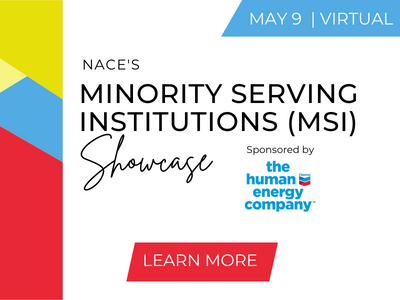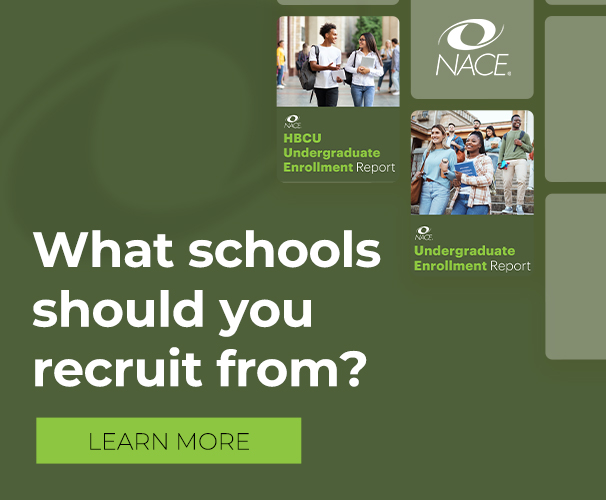Today, countless organizations incorporate diversity, equity, and inclusion in their college recruiting and hiring efforts. In fact, according to NACE’s 2023 Recruiting Benchmarks Report , more than four out of five employers have formal diversity recruitment efforts.
However, as Susanne M. Bruyère, Ph.D. points out, these programs are often focused on just a few aspects of candidate identity, such as race or gender.
“Employers need to remember that workers may be part of more than one historically underrepresented group—including people with disabilities,” explains Dr. Bruyère, professor of disability studies and academic director of the Yang-Tan Institute on Employment and Disability at Cornell University ILR School.
“So, in order to foster a truly diverse and inclusive workplace, they should be expanding their DEI efforts to encompass what is increasingly being referred to as DEIA—or diversity, equity, inclusion, and accessibility.”
Dr. Bruyère notes that disability is a part of the human condition that impacts everyone, whether they have a disability themselves or know someone who does. A significant portion of the global population has a disability—and many of them are of working age. In fact, she says, estimates indicate that one out of every 10 workers in America has some form of disability.
“That being said,” Dr. Bruyère continues, “working-age people with disabilities are half as likely to be in the workforce as their non-disabled peers, which is a tremendous inequity. Still, there’s good news: This untapped talent pool can assist in addressing the human capital needs of any business or organization. By virtue of managing a disability in an inaccessible world, people with disabilities can offer added skills and diverse perspectives that contribute to enhanced creativity, problem-solving, and organizational effectiveness. So, we really need to make disability and DEIA part of the diversity equation.”
Accounting for a range of disabilities
“Disability” is a broad umbrella term that includes many types of conditions—both apparent and non-apparent. To account for the range of disabilities in their diversity recruiting efforts and prepare their workplace to be disability inclusive, Dr. Bruyère recommends that employers:
- Start by conducting an internal accessibility assessment to make sure that both their physical facilities and information and communication technology (ICT) systems are designed to be as inclusive as possible to people with different kinds of disabilities, such as mobility, visual, hearing, and cognitive disabilities.
- Use a universal-design or “access-for-all” approach when designing physical facilities and selecting accessible workplace technology. This is a great way to ensure that individuals with a wide variety of possible disabilities can access the workplace and thrive once there.
- Have in place an actionable and transparent accommodation process that supports applicants and employees across the employment process and throughout the organization.
- Create inclusive job descriptions.
- Do not overlook the importance of organization-wide buy-in. They should alert and educate recruiters and hiring managers about their commitment to disability diversity, and encourage partnerships with local and national community employment service providers that can help source qualified candidates with disabilities for job openings.
- Make mentoring and employee resource groups (ERGs) available to early career employees, new employees, and interns to help foster a disability-inclusive culture and provide a sense of belonging.
- Provide information about resources available for support, such as appropriate contacts for accommodation requests, employee assistance programs, health and safety services, and ERGs. This shows that support is available when needed, which can reduce the anxiety many people naturally feel when starting a new job.
- Communicate to interns and recruits a commitment to inclusion, for instance, by using inclusive language and imagery in recruiting materials and involving employees with disabilities in the recruiting and hiring process.
Dr. Bruyère points to internship programs as an effective strategy for employers to increase their disability diversity. She says research shows that employers that offer internships for people with disabilities are 5.7 times more likely to hire a person with a disability than those that do not.
“Organizations can maximize this mutual benefit by being thoughtful about their onboarding processes and including supports and regular check-ins during the internship experience,” Dr. Bruyère says.
“Further, to build motivation and create a sense of attachment to the role, employers can provide a big-picture overview of the organization’s mission and goals, and how the intern’s role fits within the overarching strategic imperative of the organization.”
Similarly, she says, mentoring may be especially helpful for employees transitioning into a new job or workplace, or into a position with increased responsibility.
“Job transitions are often confusing and stressful, and require becoming familiar with new expectations, policies, and daily challenges and expectations from new coworkers and supervisors—and that’s where mentors can help,” Dr. Bruyère explains.
For example, mentors can support entry-level or rising professionals through transition periods by acting as guides, sounding boards, and confidantes—which, in turn, can help transitioning employees process new information, manage stress, gain confidence, and persist through challenges.
Demonstrating a culture that is disability inclusive online and in outreach
The team at the Employer Assistance and Resource Network on Disability Inclusion (EARN) has conducted research on effective online outreach and recruitment targeting applicants with disabilities. Dr. Bruyère, who is a team member, says the research yields important insight into the impact of messaging and how it signals disability inclusion.
The research effort was multi-layered and included a literature review; a review of the career pages and application portals of 40 randomly selected Fortune 500 company websites; and interviews, focus groups, and a survey of job seekers with disabilities.
“We learned that website features and approaches to online recruitment play an important role in influencing and attracting qualified people with disabilities and broadening employer talent pools,” Dr. Bruyère says.
“For example, career webpages that include a diversity and inclusion statement that mentions disability, as well as descriptions of flexible work arrangement policies, work-life balance programs, accommodations request processes, and disability-focused hiring and internship programs can increase your chances of attracting workers with disabilities. It is also essential that your applicant tracking system is accessible and usable for people with disabilities.”
(See a list of disability inclusion resources from EARN below.)
Meeting the expectations of students with disabilities
Students with disabilities are looking for signals that an employer is seriously committed to hiring people with disabilities. Among these key signs are:
- Visible statements by the organization’s top leadership that disability inclusion is a priority and part of the DEIA agenda;
- Hiring initiatives targeting people with disabilities;
- Relationships with community partners that source qualified candidates with disabilities for open positions;
- Clear descriptions about the accommodation process, disability-focused ERGs, and employee assistance programs (EAPs); and
- Testimonials by employees with disabilities who were successfully hired and have advanced and thrived within the organization.
“If this messaging is successful in convincing candidates with disabilities to pursue an internship or job, then an onboarding process that anticipates and addresses questions about the specifics of the job and how it relates to the overall organizational mission, performance expectations, and available supports if needed, can go far to making the candidate feel included and supported in the early stages of their internship experience,” Dr. Bruyère says.
Organizations should recognize that students with disabilities, like many employees today, want to feel valued for their individual contributions and be inspired by the company’s mission and leadership, so having an approach that looks at the unique talents and characteristics of the person and tries to match that to the right job will go a long way in resulting in a highly motivated employee who is performing strongly and can be retained longer.
Dr. Bruyère says it also means having a strong focus on diversity, equity, and inclusion that includes people with disabilities—again, expanding DEI to DEIA, with the “A” acknowledging the important role disability plays.
“It all maps back to building a culture of sincere interest and demonstrated willingness to invest in the well-being of employees,” she says.
“Today, when talented workers can be hard to find and retain, people with disabilities represent an underutilized pool of skilled candidates. Employees with disabilities can offer employers a competitive edge, often due to the perseverance and problem-solving abilities they have gained through years of innovating to remove barriers in their daily lives.
“Disability diversity can also bring creativity, innovation, problem-solving skills, and commitment to the workplace, along with improved productivity and morale of all your employees when they feel the organization will support them through whatever life changes they may encounter. With more than 9.5 million job openings in the United States, organizations would be smart to create a workplace inclusive of people with disabilities.”
Disability Inclusion Resources From EARN
The following are just some of the many disability inclusion resources produced by the Employer Assistance and Resource Network on Disability Inclusion (EARN), funded by the U.S. Department of Labor’s Office of Disability Employment Policy (ODEP) to Cornell University. The entire library of resources is available on the EARN website:
- Inclusion@Work Framework
- Online Recruitment of and Outreach to People with Disabilities: Research-Based Practices
- Encouraging Applicants with Disabilities: Job Descriptions and Announcements
- Disability Outreach and Inclusion Messaging: Assessment Checklist for Career Pages
- Company Website Disability Inclusion Messaging: Observations of Job Seekers with Disabilities
- Finding Candidates with Disabilities
- Internships
- Mentoring
- Fostering Disability-Inclusive Workplaces Through Employee Resource Groups
- Ensuring Accessibility in the Recruitment Process
- Including Neurodivergent Workers: Workspace, Work Schedules, and Other Accommodations






